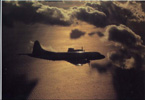juliet7bravo
Posts: 894
Joined: 5/30/2001
Status: offline

|
"As someone who has loaded torps, assorted bomb types (including ones that glow), missiles and mines on P-3 aircraft, I think I have a good feel for what it takes to load weapons on aircraft. And it takes very little equipment to do so. If it can be brought to the aircraft it can be loaded fairly quickly and simply without special equipment. On the P-3 we use a hand crank and cable to hoist weapons into the bomb bay and onto wing racks when there aren't any hydraulic lifts available. A bomb can be loaded and ready within 5 minutes. A missile such as a Harpoon takes about 10 minutes."
Yup, and you're getting them delivered to your doorstep ready to go, without all those nasty intermediate (and invisible to most eyes) steps from ship to your door. You weren't doing it in some dirt/marston mat field, under crap conditions, getting bombed at night, with half the people and a fraction of the equipment you need, day in, day out. If we want to measure peckers, I'm willing to bet I've got more experience in both combat and "primitive" conditions, handling largish quantities of ammuntion and ordnance.
"Torps require far less "care and feeding" than you think they do. Any type of shelter, even a tent will suffice to protect a torp from the elements. Doesn't have to be climate-controlled. The only assembly a torpedo required was the attachment of the warhead. Doesn't take much to do that and very little equipment is required for torpedo maintenance."
As I said...
"at the very least you're going to need a specialized air compressor/separator plant to charge the air flasks. Not to mention torps are shipped disassembled. It's not like they wait for the call for a torp loadout to bust it out of its storage container, assemble it, fuel it, charge the air flask, service it and check all the controls mechanisms"
Everything I've read about WW2 conditions, this is an accurate summary. You'd find what to disagree with in this statement? Then isn't now, and we're not talking modern weapons you break out of their sealed, humidity proof containers that have little or no end-user maintenance and/or minimal prep other than a quick diagnostic check. Those weapons also required more or less daily maintenance to be "combat ready" once assembled and prepped. Somewhere I've got all the USN checks for a "new" torpedo where they check the guidance/depthkeeping/gyroscope "stuff" after prepping it...no computer or electrical diagnostics there.
"You say you haven't found any instance of Bettys with torps flying from anything less than a size 6 airfield. Exactly what comprises a size 6 airfield? Base size in WitP is an abstraction and basically represents the number of aircraft that can be on the ground"
Absolutely. But match up airfields historically launching out torpedo armed AC, and they appear to match up with what is a rated as a size 6 or larger in the game. Size is an abstraction, but it "should" also have some bearing on capabilities. This is an observation, nothing more.
"I would think an Aviation Unit Rgt or Special Base Force is likely to have the tools and expertise necessary to handle torps with them no matter what size airfield so long as it is capable of handling torpedo aircraft. Size of the field matters not except to determine whether a loaded Betty can takeoff from it"
Really? Outside of major bases (and sometimes there) this isn't what almost any Japanese air unit history you care to read would indicate. They suffered from a chronic shortage of trained maintenance people and even basic tools. It wasn't limited to the Japanese either, as I'm sure you know. With the Allies it got better, with the Japanese it got worse. Readiness rates for the Japanese probably averaged from 50-75% at good times. Allied unit histories in forward combat areas before they got gold-plated toilets are a horror story of "making do" with next to nothing. Why would you think that any airfield would have torpedoes and qualified techs present just because the runway's long enough to handle the AC?
Excerpt from a Logistics paper: "For Want of a Spanner"
"The first clue to the problem came from the Operational Record Book (ORB) of a repair and salvage unit (RSU) in the Middle East in 1940 which opened by noting that of the RSU’s 62 personnel, only 25 had tools. So they were happy to pass on salvaged aircraft to whoever claimed them. What this meant was that in a theater then desperate for serviceable aircraft, many were standing idle because the necessary repairs could not be made for want of a spanner, let alone the necessary spares.
But the matter is important because in 1943 in Burma (South-East Asia Command or SEAC), the Beaufighters of No. 26 Squadron only sortied once every 18 days due to lack of tools and spares. The fact that the RAF had insisted on standardized nuts, bolts, and other fittings meant that special tools were not needed. Unserviceability was due to the unavailability of regular tools."
"The same with B-17s. If it can takeoff from a filed with a full bombload, then it doesn't matter whether its 1000lb or 500lb bombs or even box lunches. The hoisting equipment for 500lb and 1000lb bombs are the same, no difference at all. In fact the only difference is on the bomb cart where the cradle width has to be changed for each bomb type. So long as the support personnel they should be able to load."
Support people being a key. Crap, even the USAAF having the bomb carts in early WW2 is an open question. The Japanese more likely NOT to have them. What was one of the factoids out of "Shattered Sword"...only 6 carts for a carrier? What do you think they had at some hell hole airstrip south of nowhere? Remember Brady's pic of the "support people" muscling the bomb to the AC by brute force?
"As far as offloading them from a ship, does it matter if the pallet has 4-1000lb or 8-500lb bombs on it? They get loaded onto a lighter that takes them to a dock. A simple hoist is easily fashioned to handle the weight. If worse comes to worst, they can be rolled off the ramp and onto the beach. There are many different ways to get things to where you need them"
Again, aren't we going back to AF/port size and "infrastructure"? Does your port have cranes, or are we using the ships? Dock? Is there a dock? Is there a lighter? A simple hoist made from what? Lifting the pallet from the lighter/dock/beach onto what? A truck? Once it's on a truck, is there a road? At the end of the road we have to off-load it. Then we have to break it down. Then its got to be loaded on the bomb cart. And we're going to repeat this process scores of times to unload even a single supply ship.
The amount of manpower intensive effort to launch out a couple dozen B-17's (or Betties) from the time you off-load it from the ship, to the point where you're using your little hand crank to winch it into your AC was incredible. And we ain't even talked about AC maintenance in primitive conditions or fueling from 55 gal drums with a hand crank those couple dozen AC. Point being (if there's a point, I forget), bigger bases are going to have "bigger" infrastructure. More of it. Better. The Japanese in particular had little motor transport, and minimal port facilities at anything other than major bases.
"There are many different ways to get things to where you need them"
That sounds like one of those code phrases an officer would use that boils down to various ways of saying "all you privates are going to be working your asses off".
< Message edited by juliet7bravo -- 4/25/2006 4:44:10 AM >
|
 Printable Version
Printable Version












 .
. 
 New Messages
New Messages No New Messages
No New Messages Hot Topic w/ New Messages
Hot Topic w/ New Messages Hot Topic w/o New Messages
Hot Topic w/o New Messages Locked w/ New Messages
Locked w/ New Messages Locked w/o New Messages
Locked w/o New Messages Post New Thread
Post New Thread